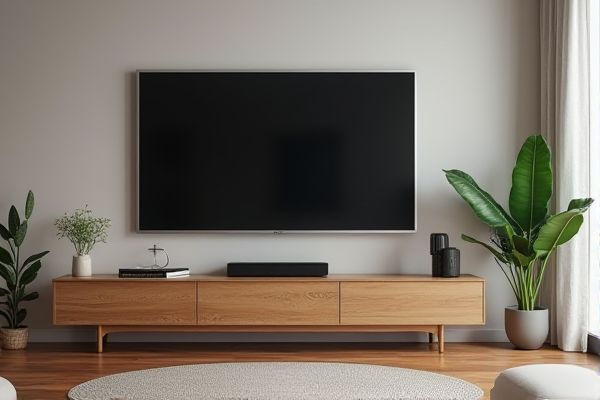
Choosing between a wall-mounted TV and a TV on a stand impacts your room's aesthetic, space utilization, and viewing comfort, with wall mounting offering a sleek, space-saving solution and stands providing flexibility and easier access to ports. Discover which option best suits your lifestyle and enhances your entertainment setup by reading the rest of the article.
Table of Comparison
| Feature | Wall-Mounted TV | TV on Stand |
|---|---|---|
| Space Efficiency | Maximizes floor space, ideal for small rooms | Requires floor space for stand or cabinet |
| Installation | Requires drilling and mounting setup | Simple setup, just place on stand |
| Viewing Angle | Fixed or adjustable with brackets | Often adjustable with swivel stands |
| Safety | Reduces tipping risk if mounted properly | May tip over if not secured |
| Cable Management | Cleaner look with cables hidden in wall | Cables visible unless managed externally |
| Accessibility | Harder to access ports and connections | Easy access to ports and controls |
| Flexibility | Less flexible to move or reposition | Highly flexible, easy to relocate |
Introduction to Wall-Mounted TVs vs TV Stands
Wall-mounted TVs offer a sleek, space-saving solution that enhances your room's aesthetics by freeing up floor space and reducing clutter. TV stands provide flexibility in placement and additional storage options for media devices, making them a practical choice for diverse room layouts. Your decision depends on factors like room size, viewing preferences, and desired functionality.
Space-Saving Benefits of Wall-Mounted TVs
Wall-mounted TVs offer significant space-saving benefits by freeing up floor area that traditional TV stands occupy, making your living room appear more spacious and organized. Installing your TV on the wall allows for seamless integration with modern decor while providing better viewing angles without bulky furniture. This setup not only enhances safety by reducing the risk of accidental knocks but also maximizes your room's usable space for other purposes.
Aesthetic Appeal: Modern Looks and Design
Wall-mounted TVs create a sleek, modern aesthetic by eliminating bulky furniture and offering a clean, minimalist look that seamlessly integrates with contemporary interior design. In contrast, TVs on stands typically add visual weight to a room, often requiring extra furniture that can clutter the space and detract from a streamlined appearance. Choosing a wall-mounted setup enhances the overall sophistication and openness of living areas, complementing modern decor trends focused on simplicity and elegance.
Flexibility and Placement Options
Wall-mounted TVs offer excellent space-saving benefits and allow for adjustable height and angle positioning, enhancing viewing comfort in various room layouts. TVs on stands provide more flexibility in relocation and easy access to ports and cables without permanent installation. Choosing between wall-mounted and stand-mounted options depends on room design, user preference for mobility, and ease of access to TV components.
Viewing Angles and Comfort Considerations
Wall-mounted TVs offer adjustable viewing angles that can reduce glare and provide a more immersive experience by positioning the screen at eye level, enhancing your comfort during extended viewing. TVs on stands provide flexibility in moving the device but may limit optimal sightlines, potentially causing neck strain if placed too low or high. Choosing between these setups depends on your room layout and how you prioritize ergonomic comfort and viewing clarity.
Installation Process: Tools and Skills Required
Wall-mounted TVs require precise tools such as studs finders, drills, and wall anchors, alongside skills in measuring and securing mounts for safe installation. In contrast, TVs on stands involve minimal setup, typically just placing the TV on a stable surface and attaching the base with basic tools or none at all. Your choice depends on your comfort level with DIY tasks and whether you prioritize a sleek, fixed setup or flexible placement.
Cable Management Solutions
Wall-mounted TVs offer superior cable management solutions by allowing wires to be concealed behind the wall or within slim cable channels, creating a clean and clutter-free look. TV stands often require additional accessories like cable organizers, clips, or raceways to hide cables, which can be less seamless and more visible. Optimizing your setup with wall-mounted installation enhances aesthetic appeal and safety by minimizing exposed cables.
Safety and Child-Proofing Factors
Wall-mounted TVs significantly reduce the risk of tipping accidents, which is a major safety advantage in homes with young children. Securing the TV at a height prevents children from pulling it down or accidentally knocking it over, enhancing child-proofing measures. In contrast, TVs on stands are more vulnerable to being toppled, requiring additional safety straps or anchors to minimize hazards.
Cost Comparison: Mounting vs Stand
Wall-mounted TVs often involve higher upfront costs due to the purchase of mounting brackets and potential professional installation fees, whereas TV stands typically require a lower initial investment with many affordable options available for different budgets. Over time, wall mounts can save space and reduce clutter, potentially lowering expenses related to additional furniture or room reorganization. Your choice between mounting and a stand should consider both the initial outlay and long-term value based on your room layout and aesthetic preferences.
Which Option Is Best for Your Living Space?
Wall-mounted TVs save floor space and offer a clean, modern look ideal for small or minimalist living spaces, while TVs on stands provide more flexibility for rearranging furniture and easy access to ports and devices. Consider the viewing height and distance to avoid neck strain, with wall mounts offering a fixed position and stands allowing adjustable placement. Evaluate your room layout, cable management preferences, and aesthetic goals to determine whether the streamlined installation of a wall mount or the convenience of a TV stand better suits your living space.
 homyna.com
homyna.com